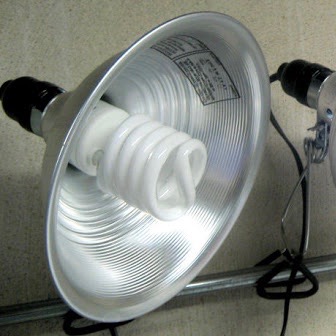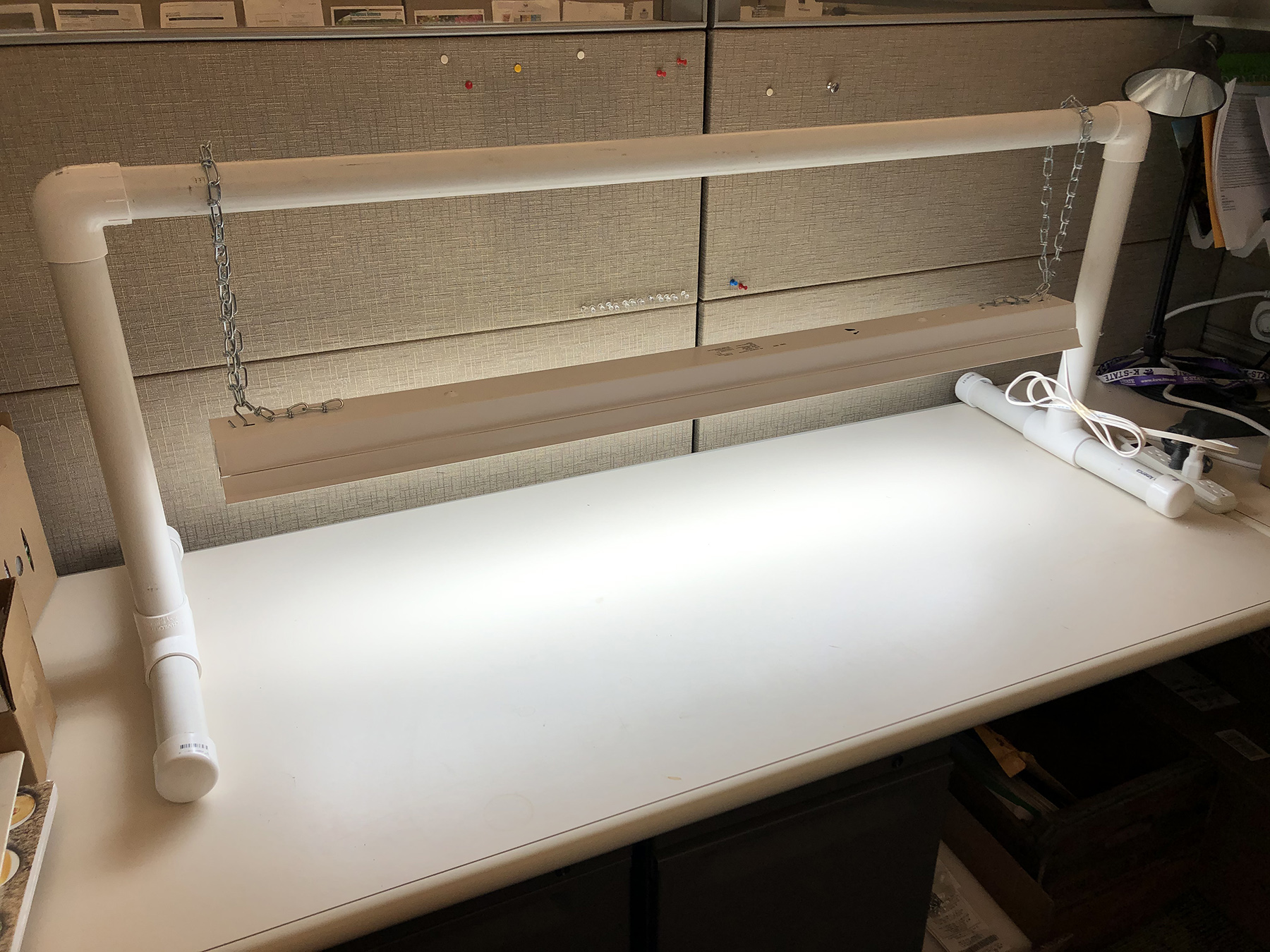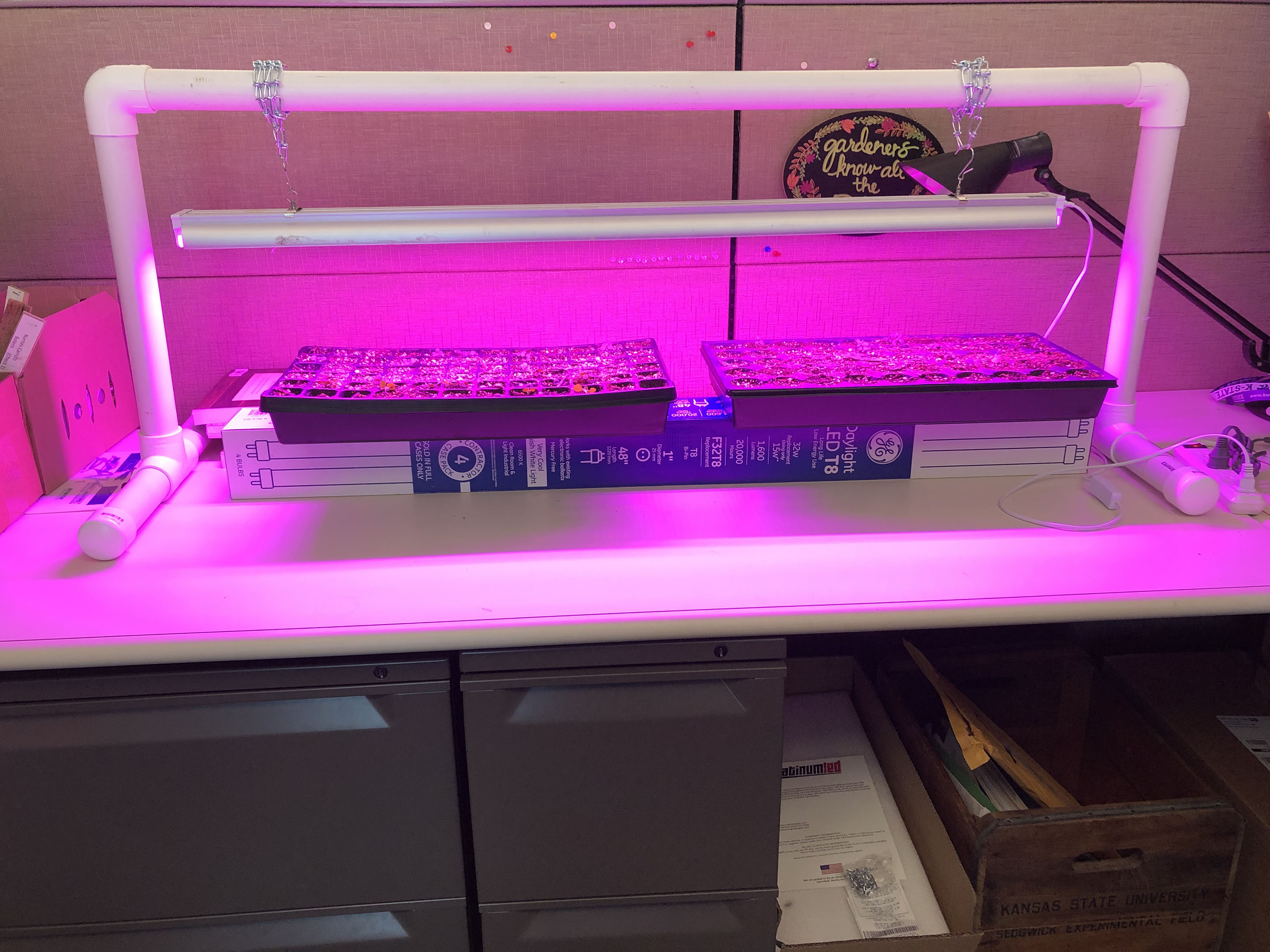Lighting options for starting seed (LEDs vs. Fluorescent)
In last month’s article, we discussed some of the indoor gardening tasks that fill the winter void for green thumbs and help prepare gardeners for greater productivity come spring. One of the reoccurring topics of interest in the horticulture wing of our office has been seed starting and artificial lighting options for growing indoors. As anyone who has relied on the light from their house fixtures and a south-facing window know, plants need greater light quantity and quality for healthy growth. And when gardeners want to get a jumpstart on their annual herbs, flowers and veggies, dedicated grow lights are necessary to produce quality plants from seed.
This topic of conversation has evolved over the last 10 years alongside advances in lighting technology and the increasing amount of ‘grow light’ products now available to consumers—especially online. Extension’s recommended setup for starting seeds indoors typically features a PVC stand and fluorescent shop light setup. But everybody’s heard about the benefits of LED's (light-emitting diodes), their touted efficiency and longevity. When it comes to horticultural lighting there are many options (including high-intensity gas discharge lamps or HID's) but for the average home seed starter, LEDs and fluorescent lights are the main options. What is the difference and how do you choose?
Fluorescent lights
The lights in this category are tried and true. They are significantly more efficient than the once common home incandescent bulbs. In simple terms, fluorescents use their energy to produce more light than heat comparatively. And there are two types commonly employed for starting seeds, tube types and compact fluorescent lamps (CFL's). For folks that are pretty new to growing indoors or have a small space, the CFLs can be a great option. These compact types fit into a standard lamp socket, unlike tubes that require a ballast/shop light fixture.

However, because of their shape and expanded surface area tubes are typically more efficient than CFL and fit well into a shelving system. The T5, T8 and T12 bulbs are the most common tube types. Bulbs are classified by T for tube and the number represents their diameter 5 = 5/8”, 8 = 8/8 or 1”, and 12 = 12/8” or 1.5”. T8s and T12s fit most standard shop light fixtures. High output T5s (HOT5) are considered as the most efficient and best in terms of light quality for fluorescent plant production but they will require a special fixture that is less often found at the hardware store.
Whether you’re using tubes or CFLs, fluorescent lighting should be kept close to growing plants (within 1-2” of plant tops) and the area they can effectively cover is limited to the surface area of the bulb. For example, when growing seedling in a standard 10 x 20” seedling tray you’ll want four tubes or two shops light fixtures (~5” wide) to cover the 10” tray width, otherwise your plants on the edges will stretch towards the middle (pictured below).
LEDs
A new technology, compared to the other lighting options in the horticulture world. LEDs are unique in their ability to produce a high quantity of light with lower energy requirements—some models producing more than twice the amount of light per watt compared to fluorescent. Some LED systems are designed to improved efficiency by delivering red and blue spectrums of light exclusively (the wavelengths required for plant growth). This is why some LEDs give off a purple glow, unlike full spectrum lights that emulate daylight. But as we know, LEDs, like those available for home lighting, come in more neutral white colors that will also work for seed starting. You can even buy led tube lights that will fit in your shop light ballast and require less energy. (pictured below).

Balanced spectrum, White LED tube in normal shop light fixture
Now for someone like a hydroponic lettuce grower operating a hundred lights and thousands of watts per hour (kWh) the cost-benefit of LEDs (especially the red and blue dual-band types) vs fluorescent will be highly tangible. For a home seed starter, you’ll be running a couple of lights at a hundred watts for a few weeks. The energy savings and cost in your scenario may only amount to a few dollars. The lifespan of LEDs is also notable with some types lasting 2 to 4 times longer than the average fluorescent. But again, even a fluorescent bulb is rated for 10,000 - 20,000 hrs and will likely be used for less than 1,000 in a typical spring seed start endeavor. Lights can be left on for up to 24hrs during the seedling stage but at minimum 14 to 16 hours each day for best growth. Because the quality of light is less from the lights than light from the sun, artificial lights must stay on for a longer period than normal day length. Some LEDs are more susceptible to degrade when running for more than 18 hr during the day—follow instructions provided with your light.
One last thing to be mindful of when purchasing LEDs, especially the red and blue grow lights, is the distance you’ll want to position the light from your plants. Unlike fluorescents, which should be positioned roughly 1” above the tops of growing seedlings, because of their greater efficiency and higher photosynthetic active radiation (PAR) some LEDs can be held at higher distance from plant tops. If your seedling leaves look bleached, move the light back and if the seedlings are stretching or leggy bring it closer till you find the sweet spot. With both LEDs and fluorescent look for lights that include the cooler blue spectrum, these will often be marked as 5000-6500K (Kelvin). And avoid the hundred dollar plus LED options that tout hundreds of watts, UV and Infrared spectrum as these are not required for good seedling growth

Dual-band LED, better photosynthesis efficiency and so light can be held at a greater distance from plants.